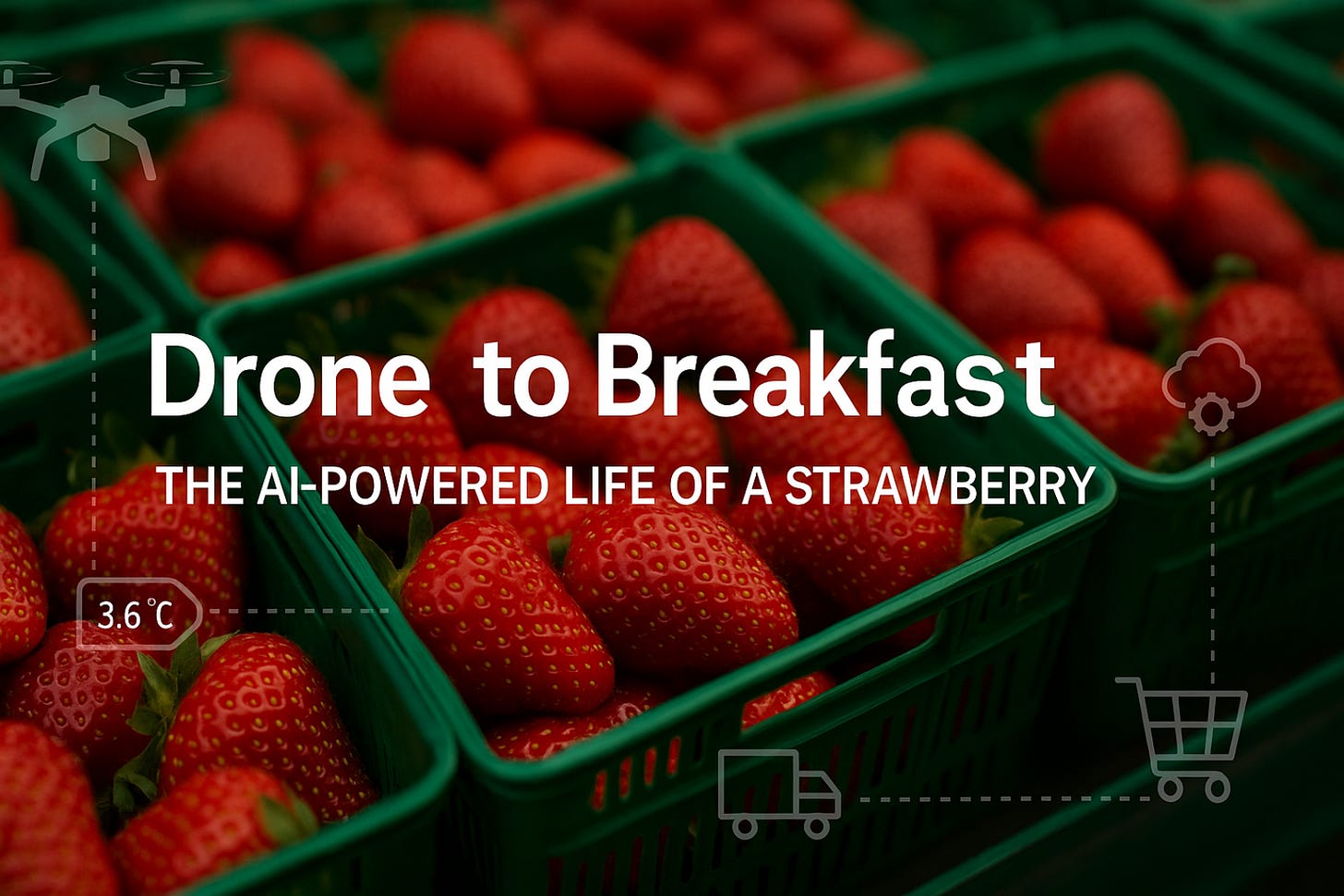From Drone to Breakfast: The AI-Powered Life of a Strawberry
How AI Is Redesigning the Farm-to-Table Journey
AI generated image of strawberries
Ever wonder how a fragile, perishable, and temperature-fussy strawberry makes it from the field to your breakfast bowl without turning to mush?
Artificial intelligence is now playing a big role. AI is becoming the guardian angel of perishable foods, guiding every step from when to pick, how to pack, which route the delivery truck should drive, and even what price to charge on the shelf in which market.
Note: I normally write my articles, sometimes with research support from ChatGPT. After I did research on farm-to-table efforts of AI, ChatGPT asked if I wanted it to write an article. For this article, I said yes. Below is mostly ChatGPT’s voice, leveraging its memory of my previous ChatGPT engagements. Informative and entertaining writing, easy to read. As an author, I always look for ways to enhance my writing style. Learning from ChatGPT is part of my process.
Cultivation: Smart Fields and Watchful Eyes
Before a strawberry ever sees sunlight, AI has been busy analyzing data.
Satellite and drone imagery feed AI systems that spot early signs of stress — like dehydration, nutrient imbalance, or disease — days before they’re visible to farmers.
Predictive irrigation models adjust watering schedules based on soil moisture and weather forecasts, conserving water while keeping crops healthy.
Tools like Microsoft FarmBeats or IBM Watson Decision Platform for Agriculture combine soil data, sensors, and weather patterns to help growers fine-tune their inputs and prevent costly loss.
Result: Stronger plants, fewer chemicals, and healthier soil — all before harvest begins.
Harvesting: Robots That Pick Just Right
At harvest time, AI steps in again.
Robotic harvesters use computer vision to identify berries at peak ripeness and pick them gently — avoiding bruises that can ruin a shipment.
Startups like Agrobot and Four Growers have created machines that scan color, shape, and texture to know exactly when a berry is perfect.
Meanwhile, in packing houses, AI inspection systems sort strawberries by size, color, and blemish level faster than human workers — ensuring consistency and minimizing waste.
Result: Faster harvests, fresher fruit, and higher quality for consumers.
The Cold Chain: Predictive Cooling and Smart Routes
Once picked, strawberries race against the clock.
AI keeps them alive — or at least deliciously fresh — during that race.
IoT sensors track temperature and humidity inside every crate or truck.
AI platforms such as Controlant and Cleveron flag anomalies in real time — for example, a failing cooling unit or vibration that could bruise the fruit.
Route optimization algorithms analyze weather, traffic, and delivery deadlines to find the fastest and most fuel-efficient path.
Result: Less spoilage (a common 20–30% in perishable supply chains) and a smaller carbon footprint.
Distribution & Retail: Forecasting Demand, Reducing Waste
In distribution centers, AI becomes the planner.
It forecasts demand using sales history, local weather, holidays, and even social media trends (yes, #StrawberrySeason spikes are real).
When a regional heatwave or rainstorm threatens yields, AI redistributes shipments dynamically — moving supply from surplus to shortage zones.
At the grocery store, computer vision systems like Afresh or Trax monitor shelf freshness and suggest markdowns or restocks.
Result: Stores keep just the right amount of fruit on hand — not too much, not too little.
Point of Sale: Smarter Pricing and Transparency
AI also helps strawberries tell their story.
Scan a QR code on some produce today and you’ll see where your food came from, when it was picked, and how far it traveled — all powered by AI-verified traceability systems.
Retailers use AI-driven dynamic pricing to lower prices as freshness windows close, reducing waste and encouraging quick sales.
And chatbots (like those being tested by Walmart and Kroger) can now answer questions such as “Where did these berries come from?” or “Are they pesticide-free?” in plain language.
Result: Informed, confident consumers — and fewer strawberries in the landfill.
The Feedback Loop: Every Berry Teaches the Next
Each stage of a strawberry’s journey produces data — soil readings, drone images, temperature logs, shelf scans.
AI weaves these together into a continuous learning system.
Over time, the algorithms refine everything:
which field produced the longest-lasting fruit
which trucking route had the fewest spoilage incidents
which local stores sold out fastest
The next planting season starts smarter than the last.
Result: A self-improving food system that learns from every berry picked.
The Bigger Picture: AI’s Promise for Perishables
Every time you bite into a perfect strawberry in January — plump, red, and sweet — there’s a quiet AI system somewhere that helped make it possible.
AI doesn’t replace human wisdom — it amplifies it.
Farmers still read the weather and smell the soil. Drivers still check their trucks. But AI now adds a layer of precision and foresight that turns fragile strawberries into data-driven success stories.
The future of food isn’t just about robots and sensors; it’s about collaboration between nature, people, and intelligent systems that care about freshness, fairness, and sustainability.
That’s not science fiction. That’s breakfast, powered by AI.




